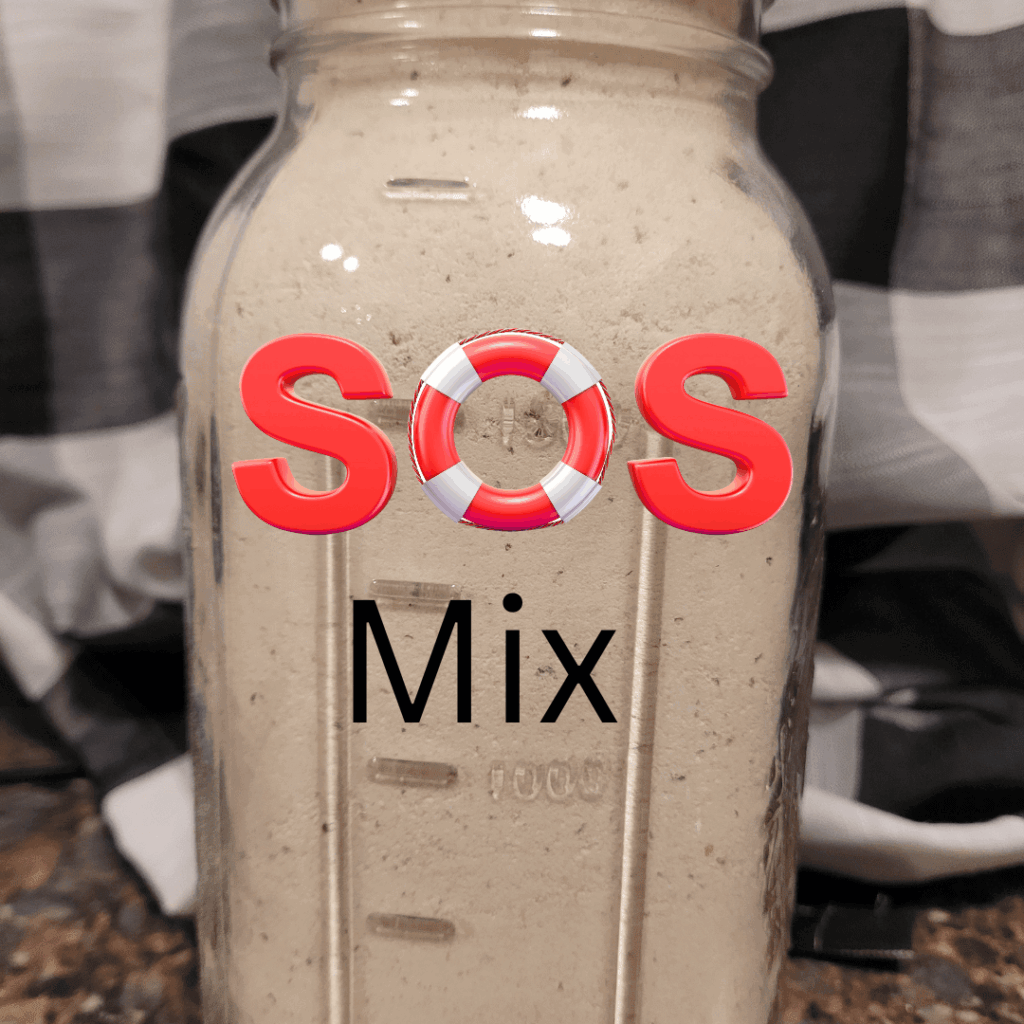Preserve the sweet, floral flavor of your homegrown quince with this easy canning guide. Learn step-by-step how to safely can quince for year-round enjoyment in jams, jellies, desserts, and more.
Every year, as the leaves start to turn and the air grows crisp, I look forward to one of my favorite backyard harvests: quince from the tree that has been growing alongside my homestead for years. There’s something magical about picking those golden, fragrant fruits, knowing they’ve thrived with nothing but sunshine, rain, and a little TLC. The first time I saw that tree when I bought this property, I wasn’t sure how well it would take to my homestead goals, but now, it’s a symbol of resilience and abundance. Harvesting quince has become a family tradition, reminding us of the rewards that come from living close to the land.
This is a pinnable post. Tap or hover over any image in this post to pin to your Pinterest Boards.
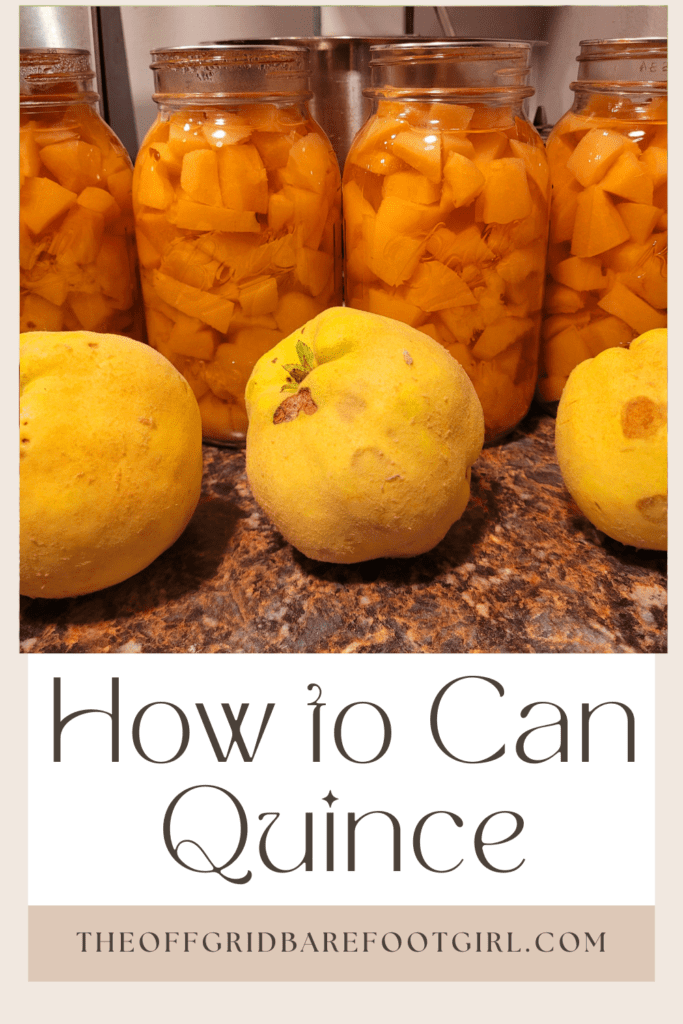
Why Quince is a Special Fruit for Self-Sufficient Living
Quince is a unique fruit, perfect for those of us living a self-sufficient lifestyle. Not only is it hardy and capable of withstanding challenging conditions, but it’s also highly versatile in the kitchen. While you can’t eat quince raw due to its astringency, it transforms into a delightful ingredient when cooked. It’s ideal for long-term storage in the form of jams, jellies, and preserves—perfect for homesteaders looking to make the most out of their harvests. Its resilience in the orchard and ability to be preserved make it a valuable fruit for anyone living off the land.
In this post, I’m going to walk you through the process of making and canning quince from start to finish. You’ll learn how to harvest, peel, and prepare quince for cooking, as well as how to create a flavorful syrup for preserving. I’ll also guide you through the canning process, ensuring your quince stays fresh and delicious for months to come. Whether you’re new to canning or a seasoned pro, this step-by-step guide will help you turn your quince harvest into a pantry staple you can enjoy all year long!
What is Quince and Why You Should Grow It
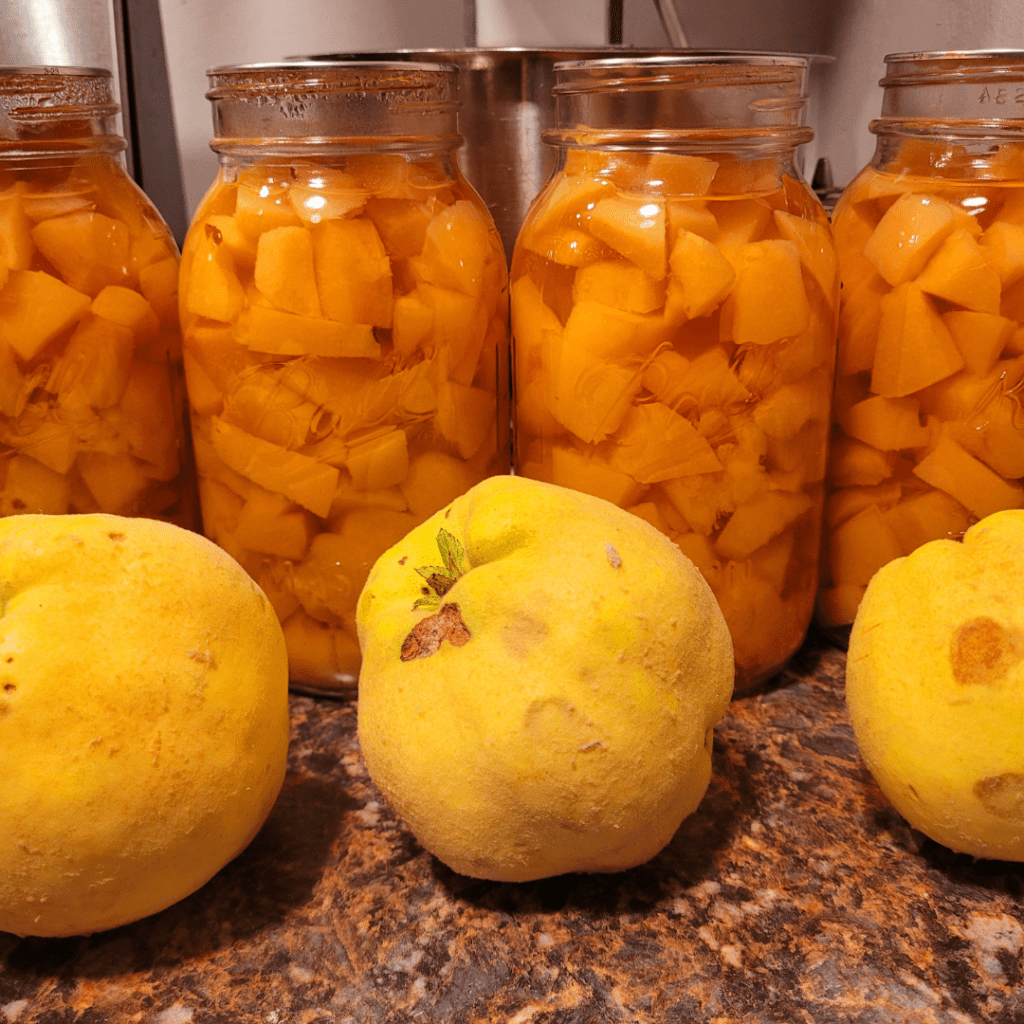
The History and Uses of Quince
Ancient Fruit with a Rich History In Cooking and Preserving
Quince is one of the oldest cultivated fruits, with a rich history that dates back to ancient civilizations. Often associated with the golden apples of mythology, quince was highly prized by the Greeks and Romans for its fragrance and versatility. Though the fruit is too tough and astringent to eat raw, it becomes soft and fragrant when cooked, developing a beautiful golden hue.
Different Uses In Jams, Desserts, and Savory Dishes
Throughout history, quince has been used in a variety of ways, particularly in jams, jellies, and marmalades. Its natural pectin content makes it perfect for preserving, while its subtle sweetness and floral notes add depth to desserts and savory dishes alike. From the Middle East to Europe, quince has graced the tables of royalty and everyday households, offering both sustenance and flavor across cultures and centuries. Today, it’s still cherished for its unique flavor and preserving qualities, making it a timeless favorite for home canners.
Benefits of Growing Quince for Self-Sufficiency
Growing quince offers a wealth of benefits for those pursuing a self-sufficient lifestyle. Quince trees are remarkably resilient, and able to thrive in a variety of climates and soil conditions with minimal care, making them ideal for off-grid homesteads. The fruit itself is highly versatile and can be preserved for long-term storage, a key advantage for anyone focused on food independence. Quince’s high pectin content makes it perfect for homemade jams, jellies, and preserves, allowing you to make the most of your harvest and reduce food waste.
Additionally, because quince trees are relatively pest-resistant and low-maintenance, they require fewer inputs and interventions compared to other fruit trees, making them a sustainable and rewarding option for self-reliant living. Whether for personal use or barter within a community, growing quince contributes to a more independent and sustainable food supply.
Harvesting and Preparing Quince for Canning

When and How to Harvest Quince
Harvesting quince is a rewarding experience, but it does require a bit of patience and attention. From my years of growing quince in my own backyard, I’ve learned that timing is everything. Quince ripens in late fall, and the key to knowing when they’re ready is their vibrant golden color and fragrant aroma.
The fruit should have a rich yellow hue, with no traces of green, and a slightly soft and fuzzy feel when pressed gently. One trick I’ve found helpful is to wait for the smell—quince has a strong, floral scent that fills the air when it’s ripe.
When it’s time to harvest, I always take extra care, as quince can bruise easily. I prefer to twist the fruit gently off the tree, rather than pulling, to avoid damaging the branches or the fruit itself. Using a sturdy ladder and wearing gloves helps make the process smoother, especially if your tree has grown as tall as mine! After years of harvesting, I’ve come to appreciate the rhythm of this process—it connects me to the changing seasons and reminds me of the simple joys of self-sufficient living.
How to Clean, Peel, and Chop Quince
Preparing quince for canning can be a bit labor-intensive, but having the right tools and techniques makes the process much smoother. I always start with a sharp vegetable peeler, which is crucial for tackling tough, thick skin on the quince. Once peeled, I use a sturdy chef’s knife to quarter the quince and remove the cores, which can be quite hard.
I’ve found that cutting the fruit on a solid, non-slip cutting board helps with control, and keeping a bowl of water with lemon juice nearby prevents the quince from browning while I work. The first time I prepped 15 quinces for this recipe, it took me about an hour and a half to peel, core, and slice everything, and I ended up with enough to fill 4 quarts of jars.
The quince will shrink during the cooking process so I measured enough for 4 quarts with a bit of extra pieces to make up for the shrinkage. I used a quart jar to measure and fill up and then dumped the chopped quince into the lemon water.
With practice, I’ve managed to cut down the prep time a bit, but the key is to go slowly and carefully, as quince can be slippery to handle. If you’re working with larger batches, I’d suggest playing something entertaining like music or your favorite podcast to help occupy your mind while peeling and chopping.
The Canning Process: Equipment and Ingredients
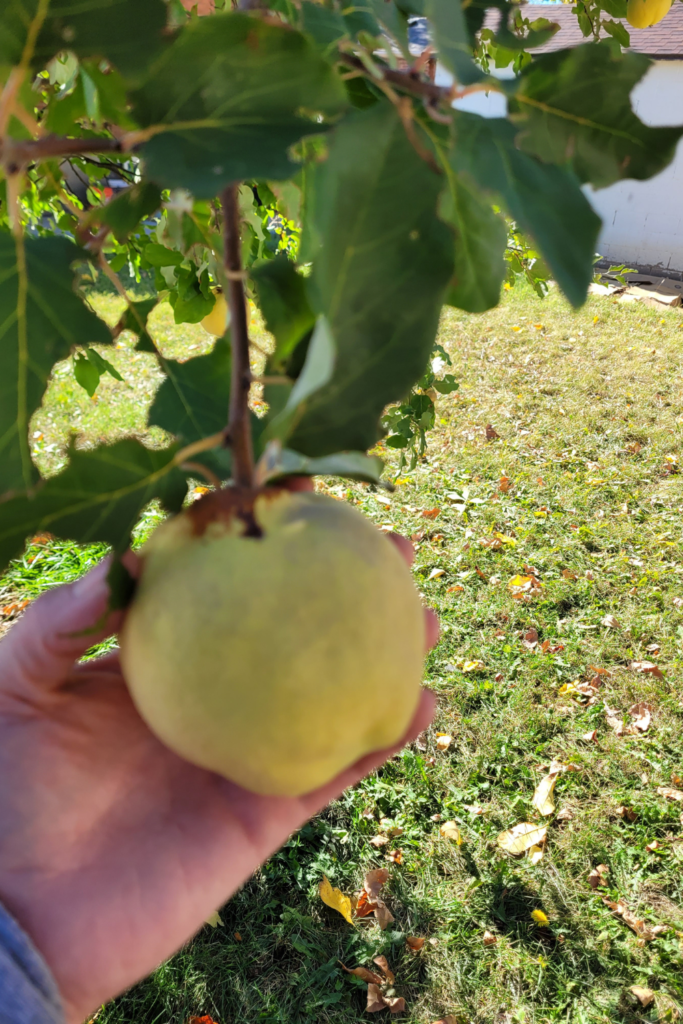
Essential Equipment for Canning Quince
Canning quince requires a few essential pieces of equipment to ensure the process is safe and effective. First and foremost, you’ll need canning jars with lids and bands—preferably quart-sized jars for storing larger batches of quince. A large pot or canner specifically designed for water bath canning is crucial, along with a jar lifter to safely remove hot jars from boiling water. A funnel makes filling the jars much easier, and a bubble remover or spatula helps eliminate air bubbles, ensuring a proper seal.
You will also need a crockpot for cooking the quince and a stockpot for cooking the syrup. Quince is too hard to eat raw and will need to be cooked first prior to canning.
Before you start canning, it’s vital to sterilize your jars to prevent any contamination. I always wash the jars in hot, soapy water and then place them in a boiling water bath for 10 minutes to ensure they’re sanitized. Additionally, keep the lids in hot water to soften the sealing compound, which helps create a tight seal. Throughout the canning process, remember to monitor the water level in your canner, adding more hot water as needed to keep the jars submerged. Following these safety tips will give you peace of mind as you preserve your quince bounty!
Ingredients You’ll Need for Canned Quince
For canning quince, gather the following ingredients to ensure a delicious and properly preserved batch:
For the Cooking Water:
Cover the 4 quarts of chopped quince (approximately 15) in the crockpot with water and lemon juice and cook on high for 3 hours. Drain the water.
For the Syrup: Cook in another crockpot or on the stovetop.
- 10 cups water.
- 4 cups sugar. Or (Light Syrup: 2 cups sugar. Medium Syrup: 4 cups sugar. Heavy Syrup: 6 cups sugar).
- ¼ cup lemon juice.
These ingredients come together to create a flavorful syrup that enhances the natural sweetness of the quince while also helping to preserve it for long-term storage. Be sure to have everything ready before you begin the canning process!
The Canning Process: Step-by-Step Guide
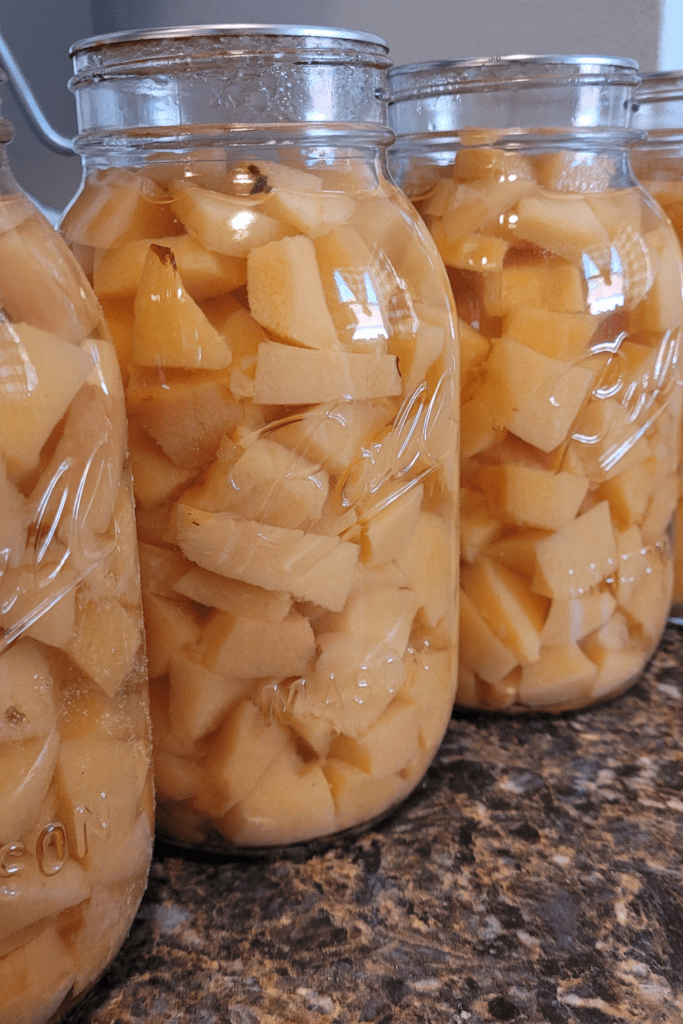
Filling and Sealing Jars for Canning
Filling jars with chopped quince requires a careful approach to ensure proper preservation and prevent air pockets.
Begin by spooning the chopped quince into each jar, and gently packing it down with a clean spoon or a bubble remover to minimize empty spaces.
It’s important to fill the jars evenly, leaving about one inch of headspace at the top, which allows for the expansion of the fruit and syrup during processing.
Once the jars are filled with quince, carefully pour the prepared syrup over the fruit, ensuring it covers the quince completely while maintaining the one-inch headspace. To remove any remaining air bubbles, run a spatula or bubble remover around the inside edges of the jar, gently pressing down on the fruit if necessary.
Finally, wipe the rims of the jars with a clean cloth to remove any residue before placing the lids on, ensuring a proper seal for long-lasting preservation.
Water Bath Canning: Ensuring Safety and Shelf Life
When it comes to safely canning quince, adhering to time and temperature guidelines is crucial for preserving your fruit effectively. For water bath canning, process your filled jars for about 20 to 25 minutes at a rolling boil, adjusting the time based on your altitude—longer for higher elevations. Use a reliable canning guide or chart to determine the exact processing time for your specific jar size. At my high elevation, I had to can my quarts for 35 minutes.
Common canning issues can arise, such as siphoning, where liquid escapes from the jar during processing, leading to less syrup and potential spoilage. To minimize this, avoid overfilling jars and ensure proper headspace. Another issue may be sealing problems, often caused by food particles on the jar rims or using cold jars with hot contents. To troubleshoot, always clean the rims thoroughly before sealing, and ensure your jars are preheated if you’re using hot food. If you notice a jar hasn’t sealed properly after cooling, simply refrigerate it and consume the contents within a few days. With these tips in mind, you can navigate common canning challenges with confidence!
Storing and Using Your Canned Quince
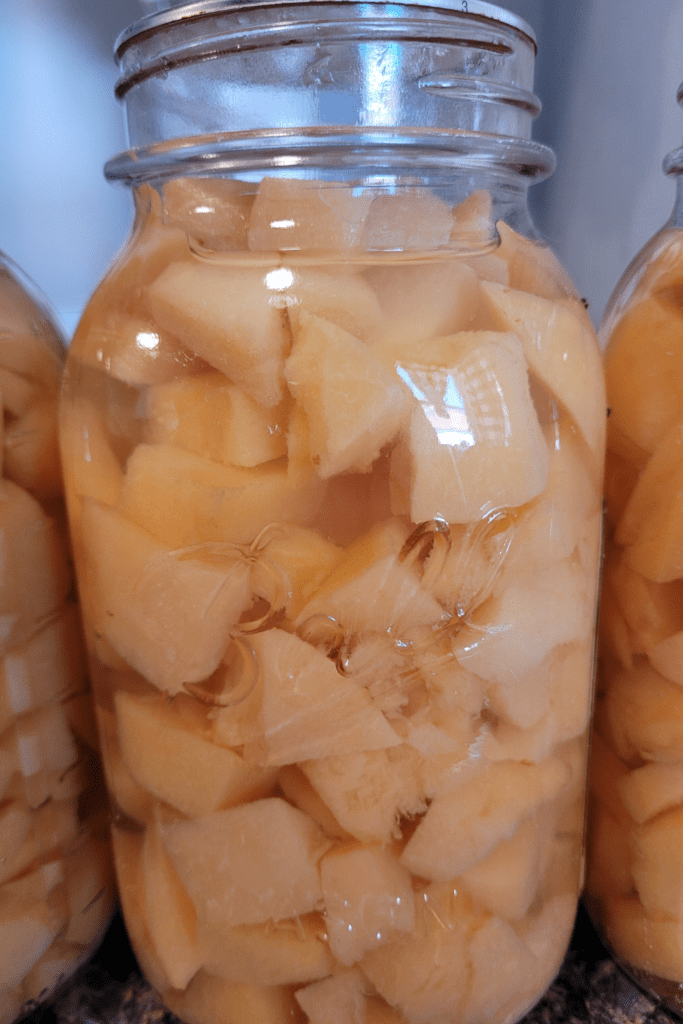
How to Store Canned Quince
Proper storage of home-canned quince is essential for ensuring its longevity and flavor. Once you’ve completed the canning process and the jars have cooled, store them in a cool, dark place, such as a pantry or cellar, away from direct sunlight. Ideally, home-canned quince can last up to a year when stored correctly, but it’s best to use it within six to eight months for optimal flavor and quality. I’ve found that labeling my jars with the date of canning helps me keep track of freshness.
In my experience, I’ve successfully stored jars of quince for over a year without any issues, and they still tasted delicious when I finally opened them. One memorable winter, I used a jar of quince in a holiday pie, and the sweet, aromatic flavor brought back fond memories of the harvest. It’s a joy to know that the fruits of my labor can be enjoyed throughout the seasons!
Creative Ways to Use Canned Quince
Home-canned quince can add a delightful twist to everyday meals, making it a versatile ingredient in both sweet and savory dishes. You can use it to create mouthwatering jams and jellies, perfect for spreading on toast or pairing with cheese for a unique appetizer.
Quince also shines in desserts like pies, tarts, or crumbles, where its sweet, floral notes complement other fruits beautifully. For a savory option, try incorporating canned quince into stews or tagines, where it adds a touch of sweetness that balances rich flavors. Gifting homemade canned quince is another wonderful way to share the bounty of your harvest. I’ve often gifted jars to family, friends, and neighbors, many of whom have come to love quince just as much as I do. I like to package the jars in a basket with a handwritten recipe card, showcasing different ways to enjoy the quince.
It’s a heartfelt gesture that not only spreads the joy of home canning but also introduces others to the unique flavors of this ancient fruit. Seeing their delight when they try it for the first time is truly rewarding!
Conclusion
In conclusion, canning quince is not just a practical way to preserve the bountiful harvest from your garden; it’s also a joyful and rewarding experience that connects you to the seasons and the fruits of your labor. The process of transforming this unique fruit into delicious preserves allows you to savor its flavors long after the last quince has fallen from the tree.
I encourage you to try canning quince for yourself—whether you’re a seasoned canner or a beginner, the satisfaction of filling your pantry with homemade jars is unmatched. With each jar you open, you’ll be reminded of the hard work and love that went into preserving that fruit, and you’ll create lasting memories with family and friends as you share your creations. So gather your quince, roll up your sleeves, and begin on this delightful canning adventure. You might just find that quince becomes a cherished staple in your kitchen, bringing sweetness to your meals and joy to your heart!
Resources: Here are some helpful resources for further information.
- Rosy Poached Quince – By David Lebovitz
- How to Cook Quince – By The Kitchn
- Baked Quince with Honey – By Real Greek Recipes

Frequently Asked Questions
1. Can I can quince without sugar?
Yes, you can can quince without sugar, but keep in mind that sugar helps preserve the fruit and enhances its flavor. If you’re looking for a lower-sugar option, consider using a sugar substitute or reducing the amount of sugar in your syrup, but be sure to follow safe canning practices.
2. How long will canned quince last?
When properly canned and stored in a cool, dark place, home-canned quince can last up to a year. However, for the best flavor and quality, it’s recommended to use it within six to eight months.
3. What should I do if my jars did not seal properly?
If you notice that a jar hasn’t sealed after cooling, don’t panic! Simply refrigerate the jar and consume its contents within a few days. Alternatively, you can reprocess the jar by transferring the quince and syrup to a clean, sterilized jar and recanning it.
4. Can I use quince in recipes without canning it first?
Absolutely! You can cook fresh quince in various dishes before canning, such as stews, desserts, or as a sweet addition to savory meals. Just remember that fresh quince is quite firm and astringent, so it’s best to cook it before consuming it.

Canned Quince
Equipment
- 4 quart jars, lids, and rings.
- Funnel, jar lifter, and debubble wand.
- 1 large water bath canner.
- 1 crockpot for cooking the raw quince. Raw quince is too hard for consumption so it needs to be cooked.
- 1 stockpot for cooking the syrup.
Ingredients
Preparing and Cooking the Quince
- 4 quarts peeled and chopped quince. About 15 quince.
- 8-10 cups water to submerge the quince for cooking in the crockpot.
- ¼ cup lemon juice.
Cooking the Syrup
- 10 cups water.
- 4 cups sugar. (Light Syrup: 2 cups sugar. Medium Syrup: 4 cups sugar. Heavy Syrup: 6 cups sugar).
- ¼ cup lemon juice.
Instructions
For the Cooking Water
- Cover the 4 quarts of chopped quince (approximately 15) in the crockpot with water and lemon juice and cook on high for 3 hours. Drain the water.
For the Syrup
- Cook in another crockpot or on the stovetop.
- Add 10 cups water to the stockpot or separate crockpot.
- Add the amount of sugar you want for the level of heaviness of your desired syrup. (Light Syrup: 2 cups sugar. Medium Syrup: 4 cups sugar. Heavy Syrup: 6 cups sugar).
- Add 1/4 cup lemon juice and mix well.
- Cook on high until sugar has dissolved.
Filling and Sealing Jars for Canning
- Spoon the chopped quince into each jar, gently packing it down with a clean spoon or bubble remover to reduce empty spaces.
- Fill the jars evenly, leaving about one inch of headspace for fruit and syrup expansion.
- Pour the prepared syrup over the quince, ensuring it covers the fruit while maintaining the headspace.
- Use a spatula or bubble remover to eliminate any air bubbles, pressing down on the fruit if needed.
- Finally, wipe the jar rims with a clean cloth to remove any residue before placing the lids on for a proper seal.
Water Bath Processing
- Process your filled jars for about 20 to 25 minutes at a rolling boil, adjusting the time based on your altitude—longer for higher elevations. Use a reliable canning guide or chart to determine the exact processing time for your specific jar size. At my high elevation, I had to can my quarts for 35 minutes.
Summary
I hope I have inspired you to stockpile your pantry for your survival needs.
If you were encouraged by this post, I invite you to check out my FREE Printables Page for fun free printables, planners, and charts.
ENTER MY FREE Printables Page HERE
Here are some more of my canning inspiration posts to check out!
Carrot Cake Butter: How to Make and Can Carrot Cake Butter
Peach Pie Filling: How to Make and Can Peach Pie Filling
Pear Pie Filling: How to Make and Can Pear Pie Filling
The Best Winter Pantry Staples to Stockpile Now!
Grapes: How to Make and Can Grape Jam
Apple Cider: How to Make Homemade Apple Cider Vinegar
How to Make and Can Cherry Plum Jam
How to Make and Can Apple Butter In Crockpot
Stockpiling Condiments for Survival: Learn How I Do It!
How to Make and Can Vegetable Pot Pie Filling
Easy Canning Applesauce Recipes to Stalk Your Pantry!
How to Make Peach Jalapeno Jam
Cherries: How to Make Cherry Pie Filling
Cherries: How to Make Cherry Syrup
Salsa: How to Make and Can Cherry Salsa
Peaches: How to Make and Can Peach Salsa
Canning Supplies You Need Now for a Successful Canning Season!
How to Make and Can Balsamic Onion Jam
Cranberry Sauce: How to Make and Can Old Fashioned Cranberry Sauce
How to Make and Can Cranberry Merry Jam
How to Make and Can Strawberry Shortcake Jam
Cherry Jam: How to Make and Can Cherry Pie Jam
Carrot Cake Jam: How to Make and Can Carrot Cake Jam
Quince Jam: How to Can a Year’s Supply of Quince Jam
Root Beer Float Jelly: How to Make and Can Root Beer Float Jelly
Blessings,
The Off Grid Barefoot Girl




